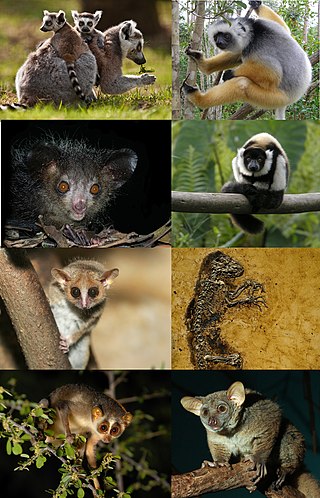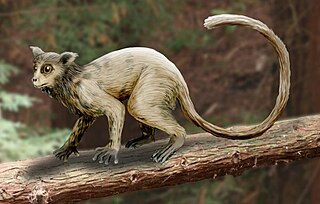
Strepsirrhini or Strepsirhini is a suborder of primates that includes the lemuriform primates, which consist of the lemurs of Madagascar, galagos ("bushbabies") and pottos from Africa, and the lorises from India and southeast Asia. Collectively they are referred to as strepsirrhines. Also belonging to the suborder are the extinct adapiform primates which thrived during the Eocene in Europe, North America, and Asia, but disappeared from most of the Northern Hemisphere as the climate cooled. Adapiforms are sometimes referred to as being "lemur-like", although the diversity of both lemurs and adapiforms does not support this comparison.

Haplorhini, the haplorhines or the "dry-nosed" primates is a suborder of primates containing the tarsiers and the simians, as sister of the Strepsirrhini ("moist-nosed"). The name is sometimes spelled Haplorrhini. The simians include catarrhines, and the platyrrhines.

Adapidae is a family of extinct primates that primarily radiated during the Eocene epoch between about 55 and 34 million years ago.

Lemuriformes is the sole extant infraorder of primate that falls under the suborder Strepsirrhini. It includes the lemurs of Madagascar, as well as the galagos and lorisids of Africa and Asia, although a popular alternative taxonomy places the lorisoids in their own infraorder, Lorisiformes.

Aegyptopithecus is an early fossil catarrhine that predates the divergence between hominoids (apes) and cercopithecids. It is known from a single species, Aegyptopithecus zeuxis, which lived around 38-29.5 million years ago in the early part of the Oligocene epoch. It likely resembled modern-day New World monkeys, and was about the same size as a modern howler monkey, which is about 56 to 92 cm long. Aegyptopithecus fossils have been found in the Jebel Qatrani Formation of modern-day Egypt. Aegyptopithecus is believed to be a stem-catarrhine, a crucial link between Eocene and Miocene fossils.

Plesiadapis is one of the oldest known primate-like mammal genera which existed about 58–55 million years ago in North America and Europe. Plesiadapis means "near-Adapis", which is a reference to the adapiform primate of the Eocene period, Adapis. Plesiadapis tricuspidens, the type specimen, is named after the three cusps present on its upper incisors.

Adapiformes is a group of early primates. Adapiforms radiated throughout much of the northern continental mass, reaching as far south as northern Africa and tropical Asia. They existed from the Eocene to the Miocene epoch. Some adapiforms resembled living lemurs.

Necrolemur is a small bodied omomyid with body mass estimations ranging from 114–346 g (4.0–12.2 oz). Necrolemur’s teeth feature broad basins and blunt cusps, suggesting their diet consisted of mostly soft fruit, though examination of microwear patterns suggests that populations from lower latitudes also consumed insects and gums.
Shoshonius is an extinct genus of omomyid primate that lived during the Eocene. Specimens identified as Shoshonius have been found exclusively in central Wyoming and the genus currently includes two species, Shoshonius cooperi, described by Granger in 1910, and Shoshonius bowni, described by Honey in 1990.

Notharctinae is an extinct subfamily of primates that were common in North America during the early and middle Eocene. The six genera that make up the group contain species that are among the most primitive of the adapiform group, which is one of the most primitive groups of primates. The evolutionary history of this subfamily has been comparatively well documented and has been used to argue for evolutionary gradualism. Though it is generally accepted that adapiforms gave rise to modern day lemurs and lorises, it is not currently known which branch of Adapiformes these living species are most closely related to. Notharctines became extinct in the middle Eocene, most likely because of a combination of factors including climatic change and competition with other North American primates.

Pelycodus is an extinct genus of adapiform primate that lived during the early Eocene (Wasatchian) period in Europe and North America, particularly Wyoming and New Mexico. It is very closely related to Cantius and may even be its subgenus. It may also have given rise to the Middle Eocene Uintan primate Hesperolemur, although this is controversial. From mass estimates based on the first molar, the two species, P. jarrovii and P. danielsae, weighed 4.5 kg and 6.3 kg respectively and were frugivores with an arboreal, quadrupedal locomotion.

Darwinius is a genus within the infraorder Adapiformes, a group of basal strepsirrhine primates from the middle Eocene epoch. Its only known species, Darwinius masillae, lived approximately 47 million years ago based on dating of the fossil site.
Adapis is an extinct adapiform primate from the Eocene of Europe. While this genus has traditionally contained five species, recent research has recognized at least six morphotypes that may represent distinct species. Adapis holds the title of the first Eocene primate ever discovered. In 1821, Georges Cuvier, who is considered to be the founding father of paleontology, discovered Adapis in fissure fillings outside of Paris, France. Given its timing and appearance in the fossil record, Cuvier did not recognize the primate affinities of Adapis and first described it as a small extinct pachyderm; only later in the 19th century was Adapis identified as a primate.
Rooneyia viejaensis is a relatively small primate belonging to the extinct monotypic genus Rooneyia. Rooneyia viejaensis is known from the North American Eocene of the Sierra Vieja of West Texas; the species is only known from the type specimen. The lack of additional fossils at this time makes it difficult to hypothesize where and how Rooneyia may have evolved. The minimal wear upon the molar teeth of the specimen has led to the assumption that the type specimen is that of a young adult. Rooneyia does not consistently fall within any one group of fossil or extant primates.
Karanisia is an extinct genus of strepsirrhine primate from middle Eocene deposits in Egypt.

Cantius is a genus of adapiform primates from the early Eocene of North America and Europe. It is extremely well represented in the fossil record in North America and has been hypothesized to be the direct ancestor of Notharctus in North America. The evolution of Cantius is characterized by a significant increase in body mass that nearly tripled in size. The earliest species were considered small-sized and weighed in around 1 kg (2.2 lb), while the later occurring species were considered medium-sized and likely weighed in around 3 kg (6.6 lb). Though significantly smaller, the fossil remains discovered of the various species of Cantius have striking similarities to that of Notharctus and Smilodectes. It is likely Cantius relied on arboreal quadrupedal locomotion, primarily running and leaping. This locomotor pattern comparable to that of extant lemurs, which has fostered the hypothesis that Cantius and other strepsirrhine adapiforms may have a close phylogenetic affinity to living lemurs.
Azibiidae is an extinct family of fossil primate from the late early or early middle Eocene from the Glib Zegdou Formation in the Gour Lazib area of Algeria. They are thought to be related to the living toothcombed primates, the lemurs and lorisoids, although paleoanthropologists such as Marc Godinot have argued that they may be early simians. It includes the genera Azibius and Algeripithecus, the latter of which was originally considered the oldest known simian, not a strepsirrhine.
Djebelemur is an extinct genus of early strepsirrhine primate from the late early or early middle Eocene period from the Chambi locality in Tunisia. Although they probably lacked a toothcomb, a specialized dental structure found in living lemuriforms, they are thought to be a related stem group. The one recognized species, Djebelemur martinezi, was very small, approximately 100 g (3.5 oz).
Plesiopithecus is an extinct genus of early strepsirrhine primate from the late Eocene.
Sivaladapis is a genus of adapiform primate that lived in Asia during the middle Miocene.












